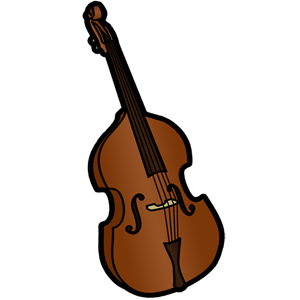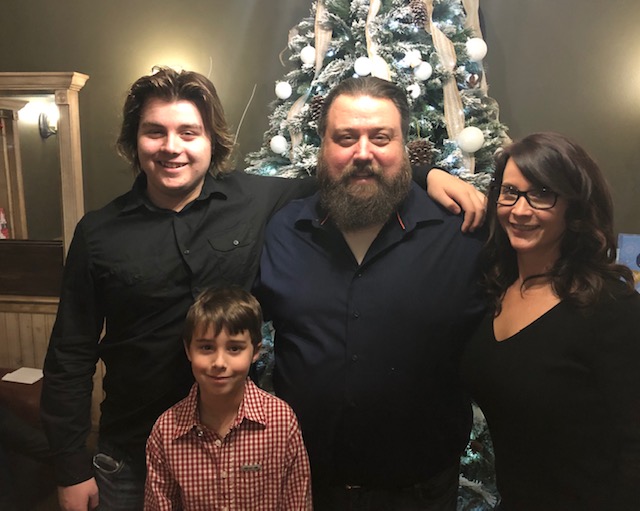Monday, March 11, 2019
 The bass, the string bass, the bass fiddle, the upright bass, the double bass, the bull fiddle, the contrabass, the bass violin, etcetera, etcetera, etcetera... What is it?
The bass, the string bass, the bass fiddle, the upright bass, the double bass, the bull fiddle, the contrabass, the bass violin, etcetera, etcetera, etcetera... What is it?
The kontrabass (in German this time) is the lowest pitched and largest string instrument in the modern symphony orchestra. Its lowest note is generally E (41 Hz) or, with the use of an extension, C (33 Hz), and, occasionally (in the case of a five-string instrument), B (31 Hz). In a symphonic context it is typically bowed, either overhanded like a cello (French style), or underhanded like a viol (German style). Unlike the other string instruments in the orchestra, the bass is tuned in fourths, from E up to G. However, other than the size and tuning, it would appear to most people that the bass is simply a larger, lower member of the violin family. This would seem to be a safe assumption, but what the bass actually is has been debated for a very long time.
Like everything in the world of symphonic strings, the history of the bass goes back to Europe in the late middle ages, and its history is intertwined with both major bowed string instrument families that began developing in that era, namely the violin and viola de gamba (or viol) families. When we see the bass in its modern context, the only other bowed instruments we see are the three modern members of the violin family. The violin has obviously been a major influence on the modern double bass, but if we were to look back at the vast majority of the last five hundred years, we would see a much more populous bowed-instrument landscape. We would see the lira da braccio, the viola d'amore, rebecs, the bowed psaltery, pochettes and any number of long-forgotten instruments. Whereas there are historians that believe that the modern bass evolved from an earlier, long-lost bass member of the violin family, most evidence points towards the biggest influence coming from the lowest register instrument of the viol family. The viol (or viola da gamba) family consists of several instruments. Most commonly, a chest of viols (term used for a full set) would consist of 2 treble, 2 tenor, and 2 bass instruments. In addition, there were also alto instruments as well as the violone, which was tuned either an octave lower than the tenor or an octave lower than the bass viol. The latter use, being an octave lower than that of the bass instrument, could arguably be the root of the name double bass. The biggest differences between the violone and the modern double bass are the number of strings (the violone has six), and the presence of tied-gut frets that are present on all members of the viol family.
By the beginning of the 19th century the viol family had virtually died off, having been surpassed in popularity by the much louder members of the violin family. During this period a more modern version of the double began to develop. At this point the frets were no longer present and the number of strings had been typically reduced to three (with four only becoming the norm at the turn of the 20th century), and the size of the instrument had grown (a full-size bass stands around six feet tall and is usually considered too large for most players, thus the 3/4 is considered the standard adult size).
Though now a distinctly different instrument from its predecessors, remnants of the viol can still be seen. The outline of the modern instrument has sloped shoulders, which differ from the members of the violin family but are in line with its viola da gamba background. Other structural aspects of the instrument can reflect the influence of either the violin or viola da gamba. The corners of the instrument can either be squared-off like those of a viol, or mimic those found on violins. The edges can either be flush to the ribs or overhang like the violin. Also, the back of the instrument can be flat like a viol or carved like a violin. Its tuning is in keeping with members of the viol family. The bow, as mentioned earlier, can be either reminiscent of a viol bow, or in the style of the French violin bow. Certain aspects of the viol are now completely absent in the modern double bass. The sound holes are always in the typical violin "f" shape as opposed to the various other shapes found in the viol family. Also absent are the elaborate scroll carvings at the head, which have now almost always been replaced by the graceful scroll of the violin family. The one aspect of the bass that is unique to the instrument is the presence of mechanical machine heads (tuners). This is a purely practical addition, resulting from the excessive string pressure present in the modern instrument.
So, what is a bass violin? It isn't exactly a viol. It's just a bass, or string bass, or bass fiddle, or upright bass, or double bass, or bull fiddle, or contrabass, etcetera, etcetera, etcetera...
...but it's not a violin.
 | Karl Franks has over 25 years of experience as a professional luthier including a decade overseeing a prominent Boston violin workshop. He is classically trained and is an expert in repair and restoration, setups, and bow work. |
How long have you been with PMC, and what brought you to the company? I have been with PMC for 7 years. Throughout my teaching career I worked with PMC so when we relocated I was excited to have an opportunity to work with the company.
Where did you grow up? Musical family? I grew up on a farm in Houston, Missouri with 5 brothers and 4 sisters. My dad was very musically inclined, as were most of my siblings. I went to Missouri State University and starting teaching band in Cassville after graduation. While teaching in Cassville for 3 years I travelled to Missouri State again for my Masters degree. I began teaching in Nevada, MO after that for the next 11 years.
Any interesting hobbies? My hobbies include kayaking, working out, and playing Scrabble.
Anything else to share? My entire teaching career I team taught with my husband, Tom Meyer. We have been married 22 years. We have 2 sons, Brett (15) and Cale (10).



| (417) 882-7000 | (573) 256-5555 | (816) 792-8301 |
| (417) 781-3100 | (405) 896-8111 | (479) 464-8877 |
| (918) 286-1555 | (636) 229-1904 | (417) 882-7000 |
